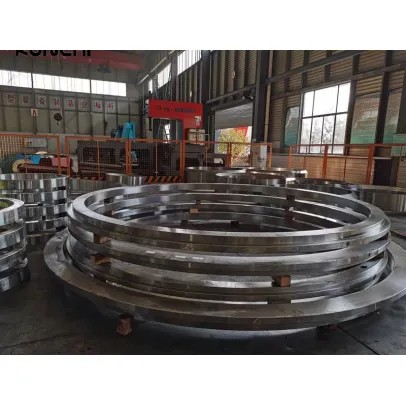Exploring the Seamless Rolled Ring Forging Process
Seamless rolled ring forging is a specialized manufacturing process used to produce high-quality, seamless rings with superior mechanical properties. These forged rings find extensive applications across various industries, including aerospace, automotive, oil and gas, and power generation.
1. Raw Material Selection:The seamless rolled ring forging process begins with the careful selection of high-quality raw materials, typically metal billets or ingots. The choice of material depends on the specific application requirements, including desired mechanical properties, corrosion resistance, and temperature resistance.
2. Heating:The selected raw material is heated to a precise temperature range in a furnace to achieve optimal forging conditions. Heating the material to the appropriate temperature is critical for reducing forging forces, enhancing material plasticity, and ensuring uniform deformation during the forging process.
3. Ring Rolling:Once heated to the desired temperature, the heated billet or ingot is placed on a ring rolling mill. The rolling mill consists of a pair of rotating rolls that gradually shape the material into a hollow, cylindrical preform called a "donut." The donut is then pierced to create a center hole, forming the starting shape for the seamless ring.
4. Ring Expansion:The next step in the seamless rolled ring forging process is the expansion of the preform to achieve the desired ring diameter and thickness. The preform is placed on a mandrel or idler roll, and radial axial pressure is applied to stretch the material outward, forming the ring shape. This process ensures a seamless, uniform grain flow throughout the ring, resulting in superior mechanical properties and structural integrity.
5. Ring Sizing and Finishing:Once the ring has been expanded to the required dimensions, it undergoes sizing and finishing operations to achieve precise tolerances and surface finish. These operations may include machining, heat treatment, and surface treatment processes to enhance the mechanical properties and surface quality of the final product.
Advantages of Seamless Rolled Ring Forging:
Enhanced Mechanical Properties: Seamless rolled rings exhibit superior mechanical properties, including high strength, toughness, and fatigue resistance, compared to rings produced by other manufacturing methods.
Reduced Material Waste: The seamless rolled ring forging process minimizes material waste by utilizing precision forming techniques and eliminating the need for additional machining operations.
Additional reading:
Mastering the Art of Ring Forgings Fabrication
Is forging cheaper than machining?
Master the Art of Forging Gear Blanks with Our Innovative Solution
Mastering the Art of Forged Step Shaft Manufacturing
The Ultimate Guide to Finding the Best Forged Parts Manufacturer
Ultimate Guide to OEM Copper Forgings: Top FAQs Answered
How to Choose Custom Forging Gear BlanksCost Efficiency: Despite the initial investment in equipment and tooling, seamless rolled ring forging offers long-term cost savings through reduced material usage, lower labor costs, and improved product performance and reliability.
Design Flexibility: Seamless rolled rings can be produced in a wide range of sizes, shapes, and materials to meet the diverse requirements of various industries and applications.
Applications of Seamless Rolled Ring Forgings:
Aerospace: Engine components, landing gear, structural parts.
Automotive: Gears, bearings, suspension components.
Oil and Gas: Drill collars, wellhead components, valves.
Power Generation: Turbine shafts, generator rotors, flanges.
Seamless rolled ring forging is a highly versatile and efficient manufacturing process that produces high-quality, seamless rings with superior mechanical properties. By understanding the key steps, advantages, and applications of the seamless rolled ring forging process, manufacturers can harness its potential to produce reliable and cost-effective solutions for a wide range of industrial applications.
Exploring the Benefits of Using Forged Gear Blanks Fabrication
How can I start block forging fabrication?
Frequently Asked Questions (FAQ)
U Shaped Spring vs. S Shaped Spring: A Comparison
10 Questions You Should Know about Forklift Safety Cage
How Does titanium alloy springs Work?
How Does tractor trailer hitch Work?
Previous: Unveiling the Art of Copper Forging: Process, Benefits, and Applications
Next: None
Related Articles
If you are interested in sending in a Guest Blogger Submission,welcome to write for us!













Comments
0